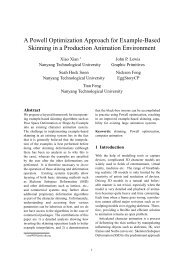A Short SVM (Support Vector Machine) Tutorial ... - JP Lewis
A Short SVM (Support Vector Machine) Tutorial ... - JP Lewis
A Short SVM (Support Vector Machine) Tutorial ... - JP Lewis
Create successful ePaper yourself
Turn your PDF publications into a flip-book with our unique Google optimized e-Paper software.
The new “invented” dimension w (squared distance from origin) allows the data to now be linearly separated by a u − v plane<br />
situated along the w axis. The problem is solved by running the same hyperplane-finding algorithm on the new data points<br />
(u, v, w) k rather than on the original two dimensional (x, y) k data. This example is misleading in that <strong>SVM</strong>s do not require<br />
finding new dimensions that are just right for separating the data. Rather, a whole set of new dimensions is added and the<br />
hyperplane uses any dimensions that are useful.<br />
Kernel trick part 3: the “kernel” summarizes the inner product. The third part of the “kernel trick” is to make use of<br />
the fact that only the dot product of the data vectors are used. The dot product of the nonlinearly feature-enhanced data<br />
from step two can be expensive, especially in the case where the original data have many dimensions (e.g. image data) – the<br />
nonlinearly mapped data will have even more dimensions. One could think of precomputing and storing the dot products in a<br />
table K(x j ,x k ) = x ′ j x k, or of finding a function K(x j ,x k ) that reproduces or approximates the dot product.<br />
The kernel trick goes in the opposite direction: it just picks a suitable function K(x j ,x k ) that corresponds to the dot product<br />
of some nonlinear mapping of the data. The commonly chosen kernels are<br />
(x ′ j,x k ) d , d = 2 or 3<br />
exp(−‖x j − x k ‖) 2 /σ<br />
tanh(x ′ j x k + c)<br />
Each of these can be thought of as expressing the result of adding a number of new nonlinear dimensions to the data and then<br />
returning the inner product of two such extended data vectors.<br />
A <strong>SVM</strong> is the maximum margin linear classifier (as described above) operating on the nonlinearly extended data. The particular<br />
nonlinear “feature” dimensions added to the data are not critical as long as there is a rich set of them. The linear classifier will<br />
figure out which ones are useful for separating the data. The particular kernel is to be chosen by trial and error on the test set,<br />
but on at least some benchmarks these kernels are nearly equivalent in performance, suggesting the choice of kernel is not too<br />
important.<br />
6







